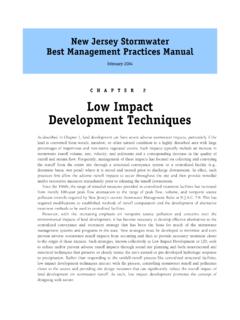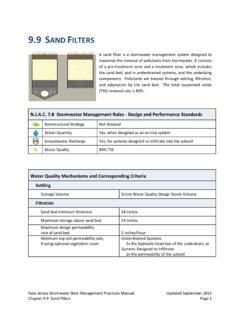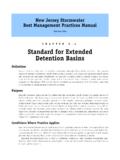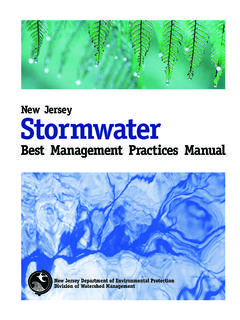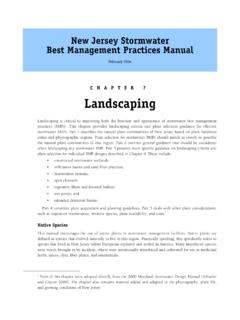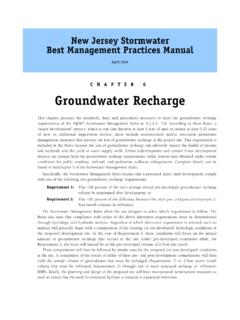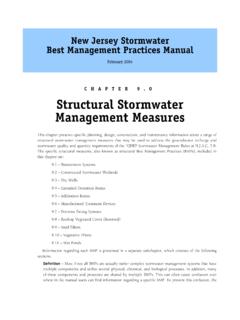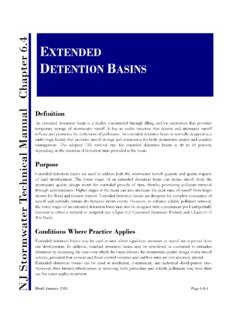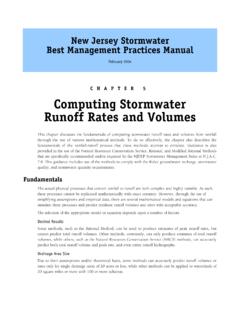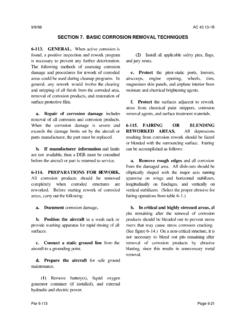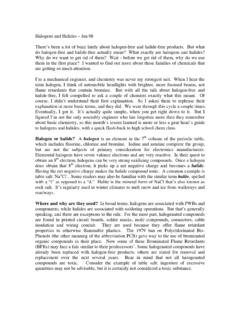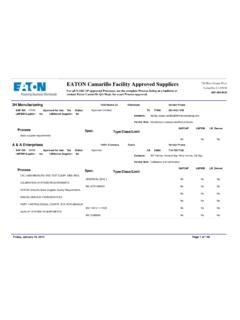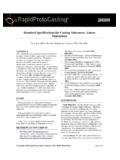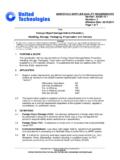Transcription of 9.11 WET PONDS - NJ Stormwater.org
1 New Jersey Stormwater Best Management Practices Manual Updated September 2014 Chapter Wet PONDS Page 1 WET PONDS Wet PONDS , also known as retention basins, are used to address the stormwater quantity and quality impacts of land development. This type of stormwater facility has an elevated outlet structure that creates a permanent pool where stormwater runoff is detained and attenuated. Wet PONDS can be designed as multi-stage, multi-function systems; extended detention in the permanent pool provides pollutant treatment for runoff from the Water Quality Design Storm through sedimentation and biological processing; detention and attenuation are also provided for larger storm event through the higher elevation outlets. When designed in accordance with this chapter, the total suspended solids (TSS) removal rate is 50 - 90%, depending upon the storage volume in the permanent pool and the duration of detention time, if extended detention is provided.
2 7:8 Stormwater Management Rules - Design and Performance Standards Nonstructural Not Allowed Water Quantity Yes, when designed as an on-line system Groundwater Recharge Not Allowed Water Quality 50% TSS removal with 1:1 pool volume ratio; up to 90% TSS removal if extended detention is also provided Water Quality Mechanisms and Corresponding Criteria Settling Minimum Ratio of Permanent Pool Volume to WQ Design Storm Runoff Volume 1:1 12 to 24-Hour Extended Detention Optional Recommended Minimum Pool Length to Width Ratio 3:1 Presence of a Permanent Pool Required Surface Area of Permanent Pool Minimum of acre New Jersey Stormwater Best Management Practices Manual Updated September 2014 Chapter Wet PONDS Page 2 Introduction Wet PONDS , also known as retention basins, are used to address the stormwater quantity and quality impacts of land development.
3 This type of stormwater facility has an elevated outlet structure that creates a permanent pool where stormwater runoff is detained and attenuated. Wet PONDS can be designed as multi-stage, multi-function systems; extended detention in the permanent pool provides pollutant treatment for runoff from the Water Quality Design Storm through sedimentation and biological processing; detention and attenuation is also provided for larger storm event through the higher elevation outlets. Wet PONDS can also be used to provide wildlife habitat, recreational benefits and water supply for fire protection; they can also be used to enhance the aesthetics of a site. However, these systems are designed primarily for stormwater treatment, so they should not be located within natural areas because they will not have the same range of ecological function.
4 Wet PONDS must have a maintenance plan and should be protected by easement, deed restriction, ordinance or other legal measures that prevent its neglect, adverse alteration, or removal. Applications Wet PONDS may be designed to reduce peak runoff rates when designed as an on-line system which provides storage volume to accommodate runoff from larger design storms. Regardless of the design storm chosen, wet PONDS must be designed for stability in accordance with the Standards for Soil Erosion and Sediment Control in New Jersey, as required by 7:8. To receive credit for a TSS removal rate of 50%, wet PONDS must be designed to treat the runoff generated by the Water Quality Design Storm and in accordance with all of the criteria below. The removal rate can be increased by providing 12 to 24 hours of extended detention or increasing the volume ratio of the permanent pool to Water Quality Design Storm.
5 New Jersey Stormwater Best Management Practices Manual Updated September 2014 Chapter Wet PONDS Page 3 Design Criteria Basic Requirements The following design criteria apply to all wet PONDS and must be met in order to receive the 50 - 90% TSS removal rate for this BMP. It is critical that all wet PONDS are designed in accordance with these criteria in order to ensure proper operation, to maximize the functional life of the system, and to ensure public safety. Additional considerations are presented in the section beginning on page 9. Minimum Inflow Drainage Area In order to function properly, wet PONDS must have a minimum inflow drainage area of 20 acres. Smaller drainage areas may be permissible if detailed analysis indicates that sufficient base or groundwater flow is available to maintain the permanent pool depth.
6 A water budget must be included in this analysis. A wet pond water budget consists of the calculated analysis of soil inundation or saturation within 1 foot of the ground surface for consecutive days that represent at least of the growing season (approximately 30 consecutive days). All of the inputs to and outputs from the wet pond must be considered; this includes runoff, flooding, groundwater inflow, evapotranspiration, and groundwater outflow. For more information on water budgets, see the Regionalized Water Budget Manual for Compensatory Wetland Mitigation Sites in New Jersey at Minimum Geometry The minimum permanent pool surface area is acres. The minimum required ratio of the permanent pool volume to the Water Quality Design Storm volume is 1:1. Detention Time In systems providing extended detention, the minimum detention time that can be used to calculate the TSS removal rate is 12 hours, and the maximum detention time that can be used to calculate the TSS removal rate is 24 hours.
7 Permanent Pool It is crucial for a wet pond to maintain its permanent pool level; if the soil at the site is not sufficiently impermeable to prevent excessive seepage, construction of an impermeable liner or other soil modifications will be necessary. Safety Safety ledges must be constructed on the slopes of all wet PONDS with a permanent pool deeper than 3 feet. Two ledges must be constructed, each 4 to 6 feet in width. The first ledge must be located between 1 and feet above the permanent pool level; the second ledge must be constructed approximately feet below the permanent pool level. New Jersey Stormwater Best Management Practices Manual Updated September 2014 Chapter Wet PONDS Page 4 Outlet Structure The minimum diameter of any outlet orifice in a wet pond is inches, as required by 7 (a)4; additional information regarding outlet structures can be found in the Residential Site Improvement Standards at 5:21-7.
8 Trash racks must be installed at the intake to the outlet structure. They must also be designed to avoid acting as the hydraulic control for the system, and they must meet the following criteria, as required by 7 (a)2 and (a): Parallel bars spaced at 1-inch intervals, up to the elevation of the Water Quality Design Storm, Minimum bar spacing: 1 inch, for elevations in excess of the Water Quality Design Storm, Maximum bar spacing: 1/3 the diameter of the orifice or 1/3 the width of weir, with a maximum spacing of 6 inches, for elevations in excess of the Water Quality Design Storm, Maximum average velocity of flow through clean rack: feet/second, under full range of stage and discharge, computed on the basis of the net area of opening through rack, Constructed of rigid, durable and corrosion-resistant material, and Designed to withstand a perpendicular live loading of 300 All wet PONDS must be designed to safely convey overflows to downstream drainage systems.
9 The design of the overflow structure must be sufficient to provide safe, stable discharge of stormwater in the event of an overflow. Safe and stable discharge minimizes the possibility of erosion and flooding in down-gradient areas. Therefore, discharge in the event of an overflow must be consistent with the current version of Standard for Off-Site Stability found in the Standards for Soil Erosion and Sediment Control in New Jersey, as required by 7:8. Wet PONDS classified as dams under the NJDEP Dam Safety Standards at 7:20 must also meet the overflow requirements of these Standards, including safe conveyance of the wet pond s spillway design storm. Wet Pond Essentials of Pollutant Removal Pollutants in runoff are treated in wet pond systems by both chemical reactions and the physical processes of dispersion and settling.
10 These processes work most efficiently under ideal plug-flow conditions; under these conditions, a pulse of runoff enters the wet pond and is treated as it moves through the system. In order to simulate these conditions, wet PONDS should be designed to maximize the length-to-width ratio. In addition to plug-flow conditions, pollutant removal is also directly affected by the surface area of the permanent pool; the settling rate of particulate solids increases with increasing surface area. The surface area of the permanent pool is dependent on site topography, minimum and maximum pool depths, and the desired settling rate; however, as previously mentioned, the minimum required permanent pool surface area is acres. New Jersey Stormwater Best Management Practices Manual Updated September 2014 Chapter Wet PONDS Page 5 The depth of the permanent pool is another important design parameter.
